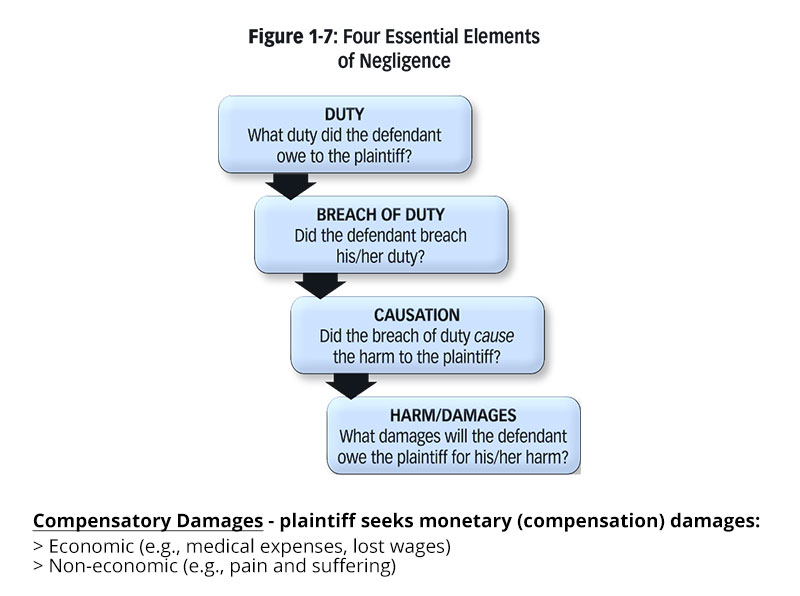To minimize injuries and subsequent negligence claims/lawsuits, exercise professionals need to be aware of their many legal duties and risk management responsibilities. When faced with a negligence lawsuit, courts will determine the standard of care (or duty) of an exercise professional. If the court finds that the exercise professional breached a duty and the breach of duty caused harm to the plaintiff (injured party), the exercise professional (and the professional’s employer) may be found negligent and, thus, liable for the plaintiff’s harm and will need to pay monetary damages. The damages can be in the millions of dollars. For example, the jury awarded the plaintiff $14,500,000 in Vaid v. Equinox (1).
Factors Courts Consider When Determining the Standard of Care
Legal scholar, the late Betty van der Smissen, stated: “if one accepts responsibility for giving leadership to an activity or providing a service, one’s performance is measured against the standard of care of a qualified professional for that situation” (2, p. 40).
A “qualified” professional possesses proper credentials and is competent. A competent exercise professional knows how (has the knowledge and practical skills) to design and deliver a “safe” and “effective” exercise program.
As described by van der Smissen,“for that situation” is determined by reference to the following three factors:
- The Nature of the Activity
- The Type of Participants
- The Environmental Conditions

Nature of the activity
The professional must be aware of the skills and abilities the participant needs to participate “safely” in the activity, e.g., the exercise professional must possess adequate knowledge and skills to lead “reasonably safe” exercise programs.
Example: Exercise professionals that lead exercise programs that are considered “advanced” that can increase the risk of injury (e.g., Olympic lifting, high intensity programs) need to have advanced knowledge and skills necessary to safely lead these types of programs, i.e., they need to be fully informed of precautions that must be taken.
Type of participants
The professional must be aware of individual factors of the participant, e.g., medical conditions that impose increased risks and know how to minimize those risks.
Example: Exercise professionals that design/deliver exercise programs for individuals with medical conditions (e.g., pregnancy, diabetes, back problems) need to possess credentials and competence in clinical exercise by completing clinical academic coursework/education as well as obtaining clinical certifications and experience (3). From a legal liability perspective, it is essential that exercise professionals fully understand any additional or unique risks the medical conditions(s) might impose and how to minimize those risks. In Bartlett v. Push to Walk (4), the court stated:
Programs like Push to Walk “May impose particular duties that an ordinary health club would not have…What would constitute…negligence would differ between an ordinary health club and a facility like Push to Walk” (p. 7).
Environmental conditions
The professional must be aware of any conditions that may increase risks, e.g., weather conditions such as heat/humidity, floor surfaces, exercise equipment, and know how to minimize those risks.
Example: Exercise professionals need to have the necessary knowledge and skills to properly implement important safety precautions to help prevent heat injuries. Knowing and implementing precautions to minimize risks associated with slippery floor surfaces and improper maintenance of equipment is also important.
Case Example: Levy v. Town Sports International, Inc. (5)
A personal trainer had a client, Levy with known osteoporosis, perform a series of jump repetitions on a BOSU ball. After a few reps, she lost her balance and fell fracturing her wrist that required surgery to have a plate and screws inserted into her wrist. She filed a negligence lawsuit against the defendant facility.* The facility filed a motion for summary judgment (request to dismiss the case). Trial court granted the defendant’s motion, and the plaintiff appealed. Upon the appeal, the appellate court reversed the trial court’s ruling. The court stated that the trainer, knowing Levy had osteoporosis, unreasonably increased the risk of harm to her by having her perform an advanced exercise. The appellate court considered the nature of the activity (jumping repetitions on a BOSU ball) and the type of participant (client with osteoporosis) and determined that the exercise professional did not meet the standard of care for that situation.
*In a negligence lawsuit, in addition to the exercise professional, the fitness facility is also named as a defendant through a legal principle called respondeat superior, in which the employer can be vicariously liable for the negligent acts of its employees.
Conclusion
Meeting the standard of care when prescribing exercise for individuals with medical conditions begins by exercise professionals obtaining the necessary credentials and competence. It was obvious that the trainer in the Levy case did not have the necessary knowledge and skills to prescribe a safe and effective program for a client with osteoporosis. The trainer failed to take important precautions to minimize the risk of a fall.
Join Joann for her webinar on this topic, Exercise Prescriptions: Linking Safety and Business Success
Information provided in this article comes from: Law For Fitness Managers and Exercise — the only comprehensive resource for fitness managers and exercise professional who want to: PROTECT THEMESELVES, THEIR BUSINESS, AND THEIR CLIENTS! For education programs that accompany the text, go to: Educational Courses (fitnesslawacademy.com)
JoAnn M. Eickhoff-Shemek, Ph.D., FACSM, FAWHP, professor emeritus, Exercise Science at the University of South Florida and president of the Fitness Law Academy, LLC, is an internationally known author and speaker. For more than 35 years, her teaching and research have focused on fitness safety, legal liability, and risk management issues. Dr. Eickhoff-Shemek is the lead author of a comprehensive legal/risk management text, Law for Fitness Managers and Exercise Professionals, and is the co-author of another textbook, Rule the Rule of Workplace Wellness Programs, published in 2020 and 2021, respectively.
References
- Vaid v. Equinox, CV136019426, 2016 LEXIS 828 (Conn. Super. Ct., 2016).
- Van der Smissen van der Smissen B. Elements of Negligence. In: Cotten DJ, Wolohan JT, eds. Law for Recreation and Sport Managers, 4th Ed. Dubuque, IA: Kendall/Hunt Publishing Company,
- Warburton DER, Bredin SSD, Charlesworth SA, et al. Evidence-Based Risk Recommendations for Best Practices in the Training of Qualified Exercise Professionals Working with Clinical Populations. Applied Physiology Nutrition and Metabolism 36, S232-S265, 2011.
- Bartlett v. Push to Walk, 2018 WL 1726262 (2018 U.S. Dist. Ct., D. N.J.).
- Levy v. Town Sports International, Inc., 101 A.D.3d 519 (2012 N.Y. App. Div. LEXIS 8543).


